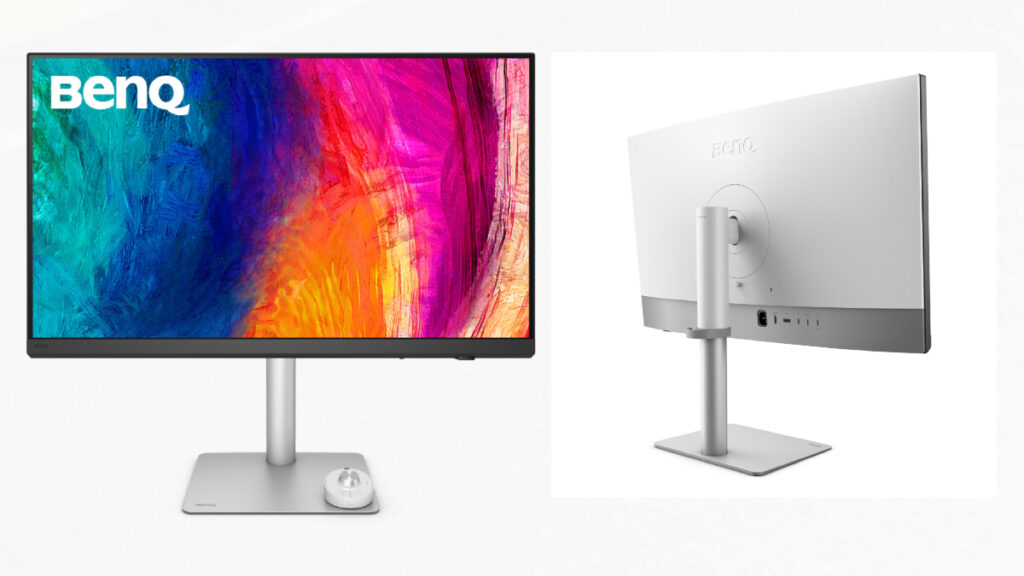The BenQ PD3226G, a 31.5-inch 4K monitor, arrived promising to meet the expectations of creative professionals. With a resolution of 3840×2160, it aimed to deliver razor-sharp detail and in day-to-day use, it didn’t disappoint. The panel’s clarity and consistency stood out, remarkably so even when viewed from different angles. “There’s no colour shift at any angle, it stays consistent throughout,” a video editor on our team confirmed after extensive use.
From a design standpoint, the monitor looks modern and well-built. Its ultra-slim bezels create a sleek, immersive workspace ideal for editing timelines or large design canvases. While the display is flat, the video editor remarked, “It’s a bit plain; if it had a slight curve, it would have been spectacular.” It’s a fair observation: while the flat panel keeps things professional and precise, some users might crave a more dramatic visual form factor.
Where the PD3226G truly impressed was colour reproduction. “It performs better than my usual monitor when it comes to colour profiles,” he said. With factory calibration targeting Delta E ≤ 2 and BenQ’s AQColor technology, the display produced precise and vibrant colours. Covering 95 per cent of the DCI-P3 colour gamut, it is ideal for colour grading, digital art and any workflow that demands accuracy.
Connectivity on the PD3226G is just as professional. It includes HDMI 2.1, DisplayPort 1.4 and Thunderbolt 4, which delivers not only fast data but also up to 90W of charging power, making it perfect for a laptop docking setup. A built-in USB-C hub, KVM switch and wireless Hotkey Puck G3 add convenience, particularly for multi-device workflows.
In real-world use, the monitor’s 144Hz refresh rate delivered smoother timeline scrubbing and playback. For video editors and animators, this level of performance felt more responsive than standard 60Hz monitors. “The resolution is more than sufficient for my editing needs,” the editor added, reaffirming that 3840×2160 provides enough detail and screen real estate for professional content work.
The ergonomic stand, with its full range of adjustments—tilt, swivel, height and pivot—helped make long editing sessions more comfortable. The overall experience felt tailored to professional demands.
That said, its HDR10 support and DisplayHDR 400 certification offer only entry-level high dynamic range. The brightness peaks at 400 nits, which may not meet the expectations of users doing serious HDR colour grading. For most creative workflows, however, this won’t be a deal breaker.
In the price range of Rs 99,998, the BenQ PD3226G delivers a competitive package with a 32-inch 4K IPS display, 95 per cent DCI-P3 colour coverage, and a high 144Hz refresh rate, which is particularly useful for video editors seeking smoother timeline scrubbing and motion playback. Its inclusion of Thunderbolt 4 with 90W power delivery, USB-C hub and KVM switch support adds to its versatility for modern workflows.
However, some monitors in the same range offer deeper HDR performance, with higher peak brightness levels and certifications such as DisplayHDR 600 or above, making them better suited for professionals focused on HDR colour grading. Others may provide slightly higher DCI-P3 or Adobe RGB coverage, which could appeal to users prioritising colour-critical work like professional photography or print design. In terms of panel technology, alternative options sometimes offer better contrast through IPS Black or Mini-LED backlighting, delivering richer blacks and improved shadow detail.
While the BenQ PD3226G offers excellent overall value for creative professionals, users with specific requirements in HDR performance or absolute colour fidelity might find more tailored solutions elsewhere in the same budget range.


